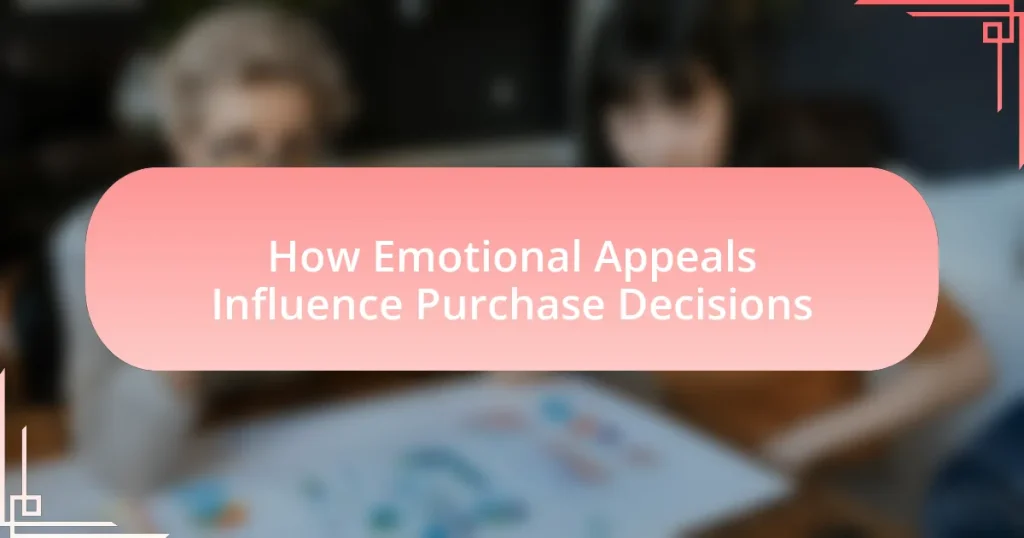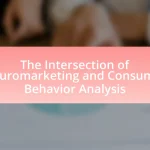Emotional appeals are marketing strategies that leverage feelings to influence consumer behavior and drive purchase decisions. This article explores the distinction between emotional and rational appeals, highlighting how emotions such as happiness, fear, and nostalgia can significantly impact consumer engagement and brand loyalty. It discusses the psychological principles underlying emotional appeals, the effectiveness of various emotional triggers in advertising, and the role of cultural differences in shaping emotional responses. Additionally, the article provides practical strategies for marketers to effectively implement emotional appeals in their campaigns, emphasizing the importance of storytelling, visual imagery, and relatable content in enhancing consumer connections and driving sales.
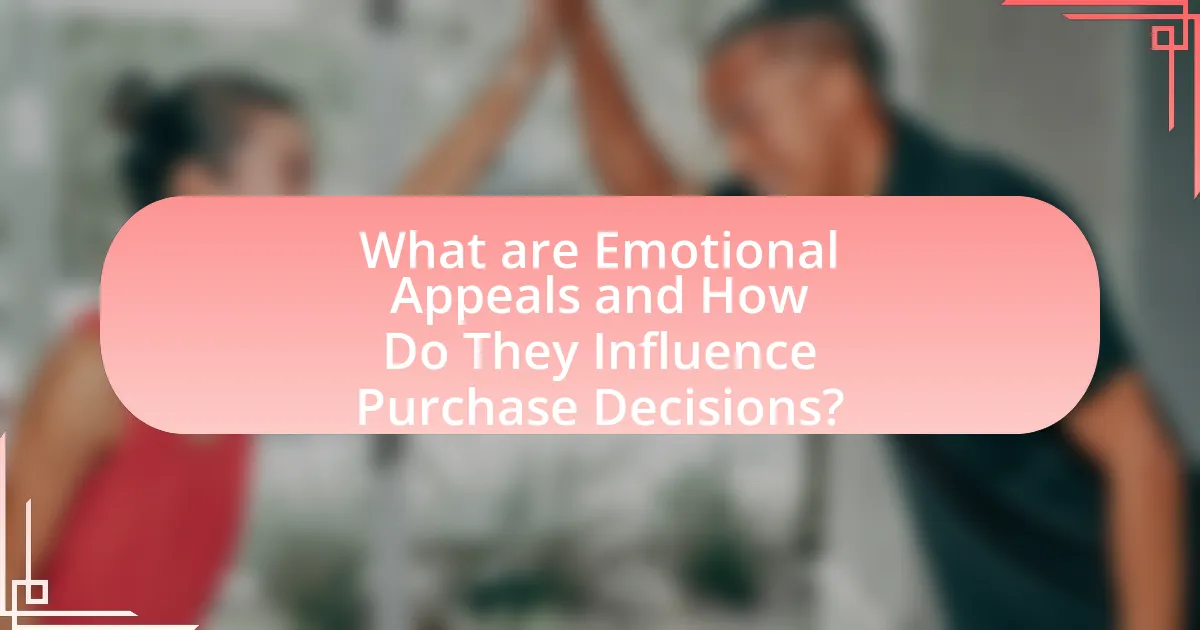
What are Emotional Appeals and How Do They Influence Purchase Decisions?
Emotional appeals are marketing strategies that evoke feelings to influence consumer behavior and drive purchase decisions. These appeals leverage emotions such as happiness, fear, nostalgia, or empathy to create a connection between the consumer and the product or brand. Research indicates that emotional responses can significantly impact decision-making; for instance, a study published in the Journal of Consumer Research found that advertisements eliciting strong emotional reactions led to higher purchase intentions compared to those that focused solely on rational arguments. This demonstrates that emotional appeals effectively enhance consumer engagement and can lead to increased sales.
How do emotional appeals differ from rational appeals in marketing?
Emotional appeals in marketing focus on eliciting feelings and creating a connection with consumers, while rational appeals emphasize logical reasoning and factual information. Emotional appeals often leverage storytelling, imagery, and relatable scenarios to evoke feelings such as happiness, nostalgia, or fear, which can drive impulse purchases. In contrast, rational appeals present data, statistics, and product benefits to persuade consumers through logical analysis, appealing to their need for information and practicality. Research indicates that emotional advertising can lead to a 23% increase in sales compared to rational advertising, highlighting the effectiveness of emotional connections in influencing consumer behavior.
What psychological principles underpin emotional appeals?
Emotional appeals are underpinned by several psychological principles, primarily including the principles of affective reasoning, social proof, and the scarcity principle. Affective reasoning suggests that emotions significantly influence decision-making, often leading individuals to prioritize feelings over logical analysis. Social proof indicates that people are more likely to adopt behaviors or beliefs if they see others doing the same, which can be leveraged in marketing to create a sense of community or belonging. The scarcity principle posits that perceived scarcity increases the value of an item, prompting emotional responses that can drive urgency in purchasing decisions. These principles are supported by research, such as Cialdini’s work on influence and persuasion, which highlights how emotional triggers can effectively sway consumer behavior.
How do emotional appeals create a connection with consumers?
Emotional appeals create a connection with consumers by triggering feelings that resonate with their personal experiences and values. These appeals engage consumers on a deeper psychological level, fostering empathy and relatability. For instance, advertisements that evoke nostalgia or happiness can lead to increased brand loyalty, as consumers associate positive emotions with the brand. Research by the Nielsen Company indicates that ads with emotional content perform twice as well as those with purely rational content, demonstrating that emotional engagement significantly influences consumer behavior and decision-making.
Why are emotional appeals effective in driving consumer behavior?
Emotional appeals are effective in driving consumer behavior because they create a strong connection between the consumer’s feelings and the brand or product. This connection influences decision-making by triggering emotional responses that can lead to increased engagement and loyalty. Research indicates that emotions significantly impact purchasing decisions; for instance, a study published in the Journal of Consumer Research found that emotional advertising can increase purchase intent by up to 23%. This demonstrates that when consumers feel a positive emotional response, they are more likely to choose a product or brand over competitors, highlighting the power of emotional appeals in shaping consumer behavior.
What role do emotions play in decision-making processes?
Emotions significantly influence decision-making processes by shaping perceptions, preferences, and behaviors. Research indicates that emotional responses can lead to quicker decisions, often bypassing rational analysis. For instance, a study published in the journal “Emotion” by Lerner et al. (2015) demonstrates that emotions like fear can lead to risk-averse choices, while happiness can promote risk-taking. This evidence shows that emotions not only affect the choices individuals make but also the way they evaluate options, highlighting their critical role in decision-making.
How do emotional responses impact brand loyalty?
Emotional responses significantly impact brand loyalty by creating strong connections between consumers and brands. When consumers experience positive emotions such as joy or trust associated with a brand, they are more likely to develop a sense of loyalty, leading to repeat purchases and advocacy. Research indicates that brands that evoke emotional responses can increase customer retention rates by up to 65%, as emotional connections foster a sense of belonging and attachment. For instance, a study by the Harvard Business Review found that emotionally connected customers are more than twice as valuable as highly satisfied customers, demonstrating the critical role of emotions in cultivating brand loyalty.
What types of emotional appeals are commonly used in advertising?
Common types of emotional appeals used in advertising include fear, happiness, sadness, and nostalgia. Fear appeals aim to evoke anxiety or concern, prompting consumers to take action to avoid negative outcomes, such as in anti-smoking campaigns. Happiness appeals focus on positive emotions, often showcasing joy or satisfaction associated with a product, which can enhance brand affinity. Sadness appeals may highlight loss or hardship, creating empathy and a desire to support a cause or brand. Nostalgia appeals evoke fond memories, encouraging consumers to connect emotionally with a brand’s heritage or values. These emotional strategies are effective because they tap into fundamental human feelings, influencing consumer behavior and decision-making.
How does fear appeal influence consumer choices?
Fear appeal significantly influences consumer choices by triggering emotional responses that can lead to increased motivation to act. When consumers perceive a threat, such as health risks or financial loss, they are more likely to engage with products or services that promise to mitigate those fears. Research indicates that advertisements utilizing fear appeal can enhance message retention and urgency, prompting consumers to make quicker purchasing decisions. For instance, a study published in the Journal of Advertising found that fear-based messages resulted in a 30% increase in consumer engagement compared to neutral messages, demonstrating the effectiveness of fear in driving consumer behavior.
What is the impact of happiness and joy in marketing messages?
Happiness and joy in marketing messages significantly enhance consumer engagement and influence purchase decisions. When marketing messages evoke positive emotions, they create a favorable perception of the brand, leading to increased customer loyalty and higher likelihood of purchase. Research by the Nielsen Company indicates that ads with positive emotional appeal can lead to a 23% increase in sales compared to those that do not evoke such emotions. Additionally, positive emotions can enhance memory retention of the brand, making consumers more likely to recall and choose the brand in future purchasing situations.
How can marketers effectively utilize emotional appeals?
Marketers can effectively utilize emotional appeals by crafting messages that resonate with consumers’ feelings and values. This approach involves understanding the target audience’s emotional triggers, such as happiness, fear, or nostalgia, and integrating these elements into advertising campaigns. For instance, a study published in the Journal of Consumer Research found that advertisements evoking positive emotions can increase brand loyalty and purchase intent by up to 20%. By leveraging storytelling techniques that evoke empathy or connection, marketers can create memorable experiences that influence consumer behavior and drive sales.
What are the potential risks of using emotional appeals in marketing?
The potential risks of using emotional appeals in marketing include consumer backlash, misinterpretation of the message, and the potential for manipulation. Consumer backlash can occur when audiences perceive emotional appeals as insincere or exploitative, leading to negative brand perception. Misinterpretation of the message can happen if the emotional appeal does not resonate with the target audience, resulting in confusion or disengagement. Additionally, emotional manipulation can lead to ethical concerns, as consumers may feel coerced into making purchases based on emotional triggers rather than informed decisions. Research indicates that 60% of consumers are wary of brands that use emotional manipulation, highlighting the importance of authenticity in marketing strategies.
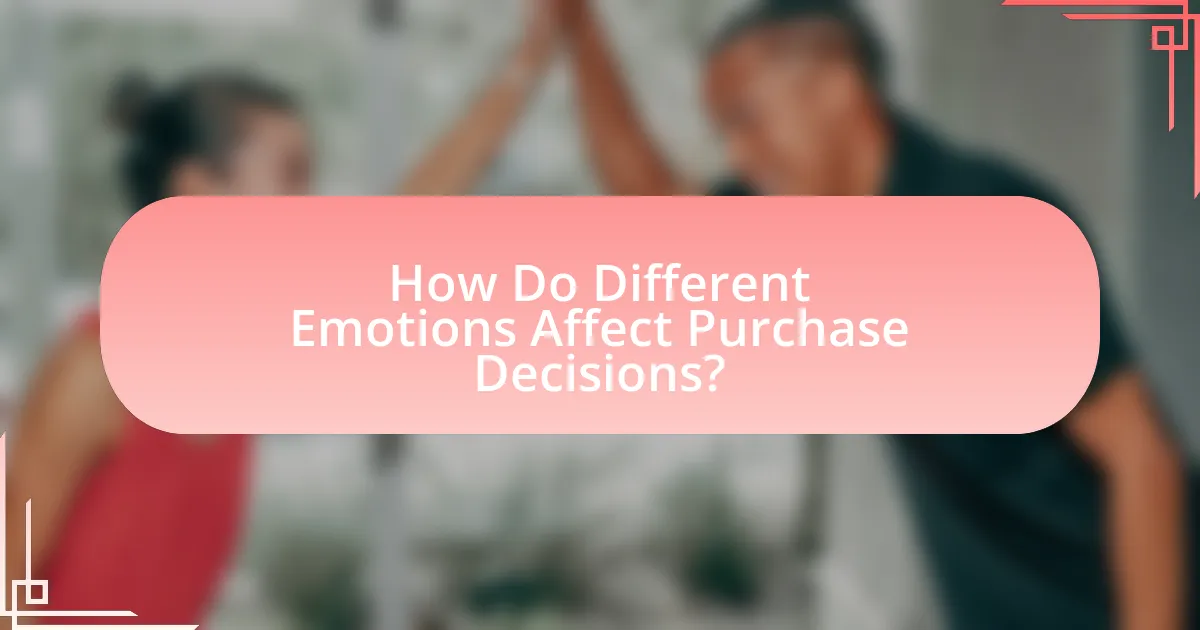
How Do Different Emotions Affect Purchase Decisions?
Different emotions significantly influence purchase decisions by affecting consumer behavior and perceptions. For instance, positive emotions like happiness can lead to impulsive buying, as consumers are more likely to make purchases when they feel good. Conversely, negative emotions such as fear or sadness can trigger a desire for comfort or security, prompting consumers to buy products that provide reassurance or alleviate discomfort. Research by the Journal of Consumer Research indicates that emotional states can alter the perceived value of products, with consumers often willing to pay more for items that evoke positive feelings. Thus, emotions play a crucial role in shaping purchasing choices and behaviors.
What emotions are most commonly targeted in advertising?
The emotions most commonly targeted in advertising are happiness, fear, and trust. Advertisers leverage happiness to create positive associations with products, often using imagery and messaging that evoke joy and satisfaction. Fear is utilized to highlight potential risks or negative outcomes, prompting consumers to take action to avoid those scenarios. Trust is cultivated through brand credibility and reliability, encouraging consumers to feel secure in their purchasing decisions. Research indicates that emotional appeals significantly influence consumer behavior, with studies showing that ads eliciting strong emotional responses can increase purchase intent by up to 23%.
How does nostalgia influence consumer purchasing behavior?
Nostalgia significantly influences consumer purchasing behavior by evoking positive emotions and memories associated with the past, which can lead to increased brand loyalty and purchasing intent. Research indicates that nostalgic feelings can enhance consumers’ emotional connection to products, making them more likely to choose brands that resonate with their personal history. For instance, a study published in the Journal of Consumer Research found that nostalgia can increase consumers’ willingness to pay for products that remind them of their childhood, demonstrating that emotional ties can directly impact purchasing decisions.
What is the effect of anger on consumer reactions to brands?
Anger significantly influences consumer reactions to brands, often leading to negative evaluations and behaviors. When consumers experience anger, they are more likely to express dissatisfaction, engage in negative word-of-mouth, and switch to competing brands. Research indicates that anger can amplify the likelihood of consumers taking punitive actions against brands, such as leaving negative reviews or boycotting products. For instance, a study published in the Journal of Consumer Research found that consumers who felt anger towards a brand were more inclined to share their negative experiences on social media, thereby damaging the brand’s reputation. This demonstrates that anger not only affects individual consumer behavior but can also have broader implications for brand perception and loyalty.
How do cultural differences impact emotional appeal effectiveness?
Cultural differences significantly impact the effectiveness of emotional appeals in marketing. Different cultures prioritize distinct values and emotional triggers, which can influence how consumers respond to advertisements. For instance, collectivist cultures, such as those in many Asian countries, often resonate more with emotional appeals that emphasize community and family, while individualistic cultures, like those in the United States, may respond better to messages highlighting personal achievement and self-expression. Research by Hofstede (1980) on cultural dimensions illustrates these differences, showing that individualism versus collectivism shapes consumer behavior and emotional engagement. Thus, marketers must tailor their emotional appeals to align with the cultural context of their target audience to enhance effectiveness.
What emotions resonate more in collectivist cultures compared to individualistic cultures?
Collectivist cultures resonate more with emotions such as harmony, belonging, and community, while individualistic cultures emphasize emotions like independence and self-expression. Research indicates that collectivist societies prioritize group cohesion and social relationships, leading to a stronger emotional connection to collective well-being. For instance, studies show that advertisements targeting collectivist cultures often highlight family ties and social harmony, which are more effective in influencing purchase decisions than those focusing on individual success. In contrast, individualistic cultures respond better to messages that promote personal achievement and autonomy, reflecting their values of self-reliance and individual rights.
How can marketers tailor emotional appeals to different cultural contexts?
Marketers can tailor emotional appeals to different cultural contexts by understanding and integrating cultural values, beliefs, and emotional triggers specific to each target audience. For instance, in collectivist cultures, emotional appeals that emphasize community, family, and social harmony are more effective, as seen in campaigns that highlight group achievements or familial bonds. Conversely, in individualistic cultures, marketers should focus on personal success, independence, and self-expression, which resonate more strongly with consumers. Research by Hofstede (1980) on cultural dimensions illustrates these differences, showing that emotional responses are significantly influenced by cultural orientation, thereby validating the need for culturally relevant marketing strategies.
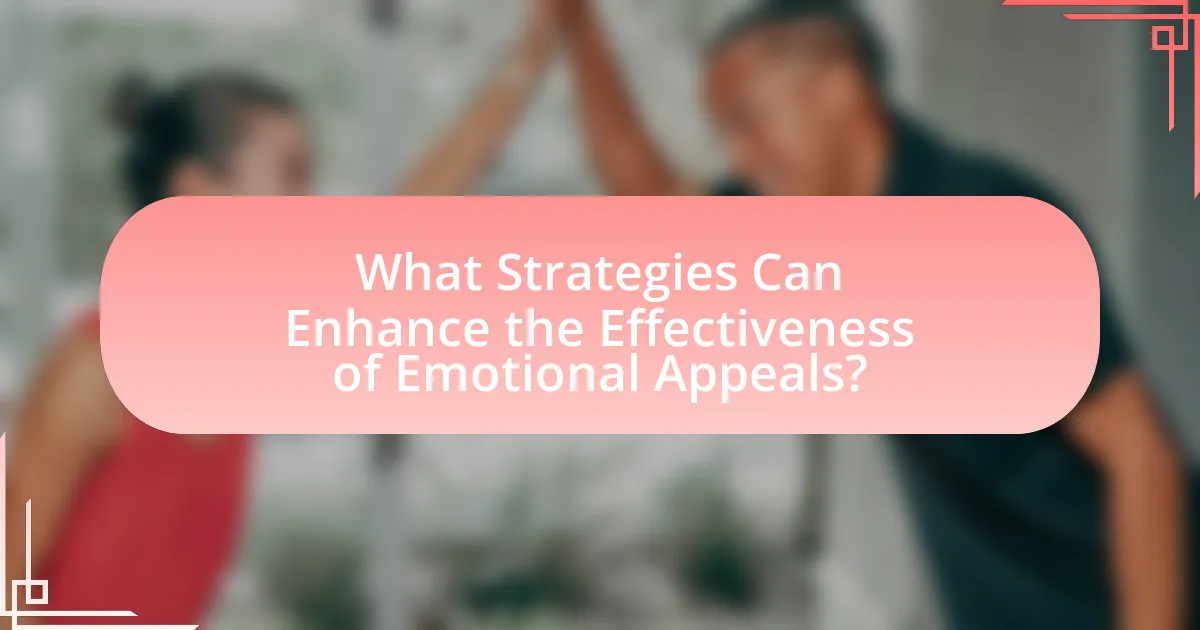
What Strategies Can Enhance the Effectiveness of Emotional Appeals?
To enhance the effectiveness of emotional appeals, marketers should utilize storytelling, evoke relatable emotions, and leverage social proof. Storytelling engages consumers by creating a narrative that resonates with their experiences, making the message more memorable. For instance, a study published in the Journal of Consumer Research found that narratives can significantly increase emotional engagement and persuasion. Evoking relatable emotions, such as happiness or nostalgia, can create a stronger connection between the consumer and the brand, leading to increased purchase intent. Additionally, incorporating social proof, such as testimonials or user-generated content, can validate emotional appeals by showing that others have had positive experiences, thereby increasing trust and credibility.
How can storytelling be used to evoke emotions in consumers?
Storytelling can evoke emotions in consumers by creating relatable narratives that resonate with their experiences and values. When brands craft stories that feature characters facing challenges or achieving goals, they tap into consumers’ empathy and aspirations, fostering a deeper emotional connection. Research indicates that emotionally charged stories can increase engagement and retention; for instance, a study published in the Journal of Consumer Research found that narratives can enhance emotional responses, leading to stronger brand loyalty and increased likelihood of purchase. By effectively utilizing storytelling, brands can influence consumer behavior through emotional appeals, ultimately driving purchase decisions.
What elements make a story compelling in marketing?
Compelling stories in marketing are driven by relatable characters, emotional resonance, a clear conflict, and a satisfying resolution. Relatable characters allow consumers to see themselves in the narrative, fostering a personal connection. Emotional resonance engages the audience’s feelings, making the story memorable and impactful. A clear conflict creates tension that keeps the audience invested, while a satisfying resolution provides closure and reinforces the brand’s message. Research indicates that narratives with these elements can increase consumer engagement and influence purchasing decisions, as demonstrated by a study published in the Journal of Consumer Research, which found that emotionally charged stories significantly enhance brand recall and preference.
How does narrative structure affect emotional engagement?
Narrative structure significantly affects emotional engagement by shaping how a story is perceived and experienced by the audience. A well-structured narrative, which includes elements such as exposition, rising action, climax, and resolution, creates a framework that guides emotional responses. For instance, research indicates that narratives with a clear structure enhance empathy and connection, as they allow audiences to anticipate outcomes and invest emotionally in characters’ journeys. Studies, such as those by Green and Brock (2000), demonstrate that structured narratives lead to greater transportation, which is the immersive experience that fosters emotional engagement. This emotional involvement can influence decision-making, particularly in contexts like advertising, where emotionally engaging narratives can enhance consumer connection to a brand and ultimately drive purchase decisions.
What role does visual imagery play in emotional marketing?
Visual imagery plays a crucial role in emotional marketing by evoking feelings and associations that influence consumer behavior. This type of imagery can create a strong emotional connection between the brand and the consumer, leading to increased engagement and a higher likelihood of purchase. Research indicates that visuals can trigger emotional responses more effectively than text alone; for instance, a study published in the Journal of Consumer Research found that emotional imagery significantly enhances the memorability of advertisements, leading to a 23% increase in purchase intent. Thus, effective use of visual imagery in marketing strategies can directly impact consumer decisions by fostering emotional resonance.
How can colors and images evoke specific emotions?
Colors and images can evoke specific emotions through psychological associations and cultural meanings. For instance, the color red is often linked to feelings of excitement and urgency, which can stimulate appetite and encourage impulse buying, as evidenced by its frequent use in fast-food branding. Similarly, images that depict serene landscapes can induce feelings of calmness and relaxation, influencing consumers to associate products with tranquility. Research by the Institute for Color Research indicates that color can increase brand recognition by up to 80%, demonstrating its significant impact on emotional responses and purchasing behavior.
What are the best practices for using visuals in emotional appeals?
The best practices for using visuals in emotional appeals include selecting images that evoke strong emotions, ensuring high quality and relevance, and aligning visuals with the message’s tone. Research indicates that visuals can significantly enhance emotional engagement; for instance, a study published in the Journal of Consumer Research found that emotionally charged images can increase message retention and influence decision-making. Additionally, using relatable characters or scenarios in visuals can foster empathy, making the emotional appeal more impactful.
What are some practical tips for implementing emotional appeals in marketing campaigns?
To effectively implement emotional appeals in marketing campaigns, marketers should focus on storytelling, relatable content, and visual imagery. Storytelling engages consumers by creating a narrative that resonates with their experiences and emotions, making the brand more memorable. Relatable content ensures that the audience sees themselves in the message, fostering a connection that can lead to increased loyalty. Visual imagery, such as evocative images or videos, can trigger emotional responses quickly and powerfully, enhancing the overall impact of the campaign. Research indicates that emotional advertising can lead to a 23% increase in sales compared to non-emotional ads, highlighting the effectiveness of these strategies in influencing purchase decisions.
